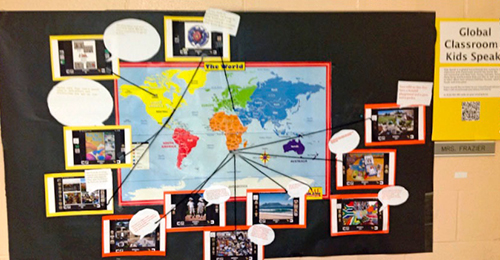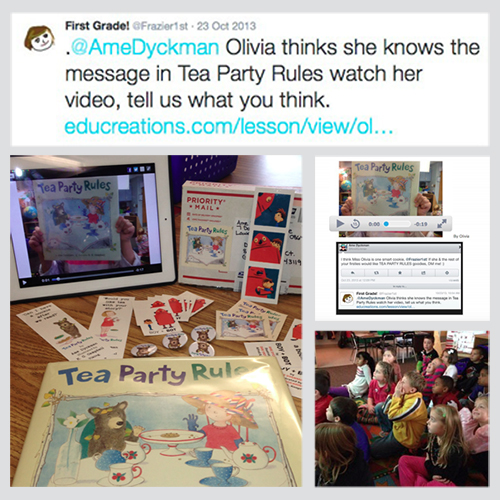Chapter 3: Digital Reading and Writing to Connect with Others
3.4 Building Connections

Keep in mind we are reading tweets to build new connections that will reach beyond our classrooms, to learn about the person behind the work and to see other perspectives. The connections we make should spark our interest, push our thinking, and be active in sharing and working together. To do this, we begin by looking at the class sending the tweet. We click on the name of the sender and we are directed to the user’s profile summary.
Here we can learn about the class who is tweeting. We can read other tweets written by this class; we can see who they follow and who follows them. We can look to see how active they are on Twitter. We want a class who tweets regularly to increase the power of our connections. We pause for a few minutes to read through the tweets to see what the class shares and what they are learning.

We ask ourselves:
- Are we are interested in what they are tweeting?
- Do we have similar interest we could share with them?
- Would this connection push our thinking?
- Are we curious about their geographical location or culture or customs?
- Are they active on Twitter?
- Who is following the class and who the class is following?
- Do we see familiar names?
- Do they follow us?
- Are there names here we want to explore more?
As our connections grow we begin to see familiar names between classes and as these names increase so does our community of learners. We are well on our way to establishing collaborative connections.
Often classes will provide a link to their classroom blogs in their profile. If we are interested in learning more about this class we visit their blog. As we read the class blog we look again for learning we are curious about, familiar learning, student work samples and any information that will help us learn about the class as learners. Finally we are ready to make a decision on whether or not we will follow this class on Twitter. We discuss what we have learned, think about how it will impact our classroom and make a decision, to follow or not to follow.
Sometimes this is an easy decision, other times it’s discussed over a few days. I want the students to feel invested and connected. When they talk about our connections I want them to know the classes by name, know their interest and to feel value in the connection and in the power of being a connected learner. Remember my goal is to instill a sense of acceptance and understanding of others and we can’t do this with a superficial connection. To enhance these connections, we need to be able to ask questions and listen to understand and share our customs and beliefs knowing they will be valued in return. Students also need to know their audience as they choose who they will share their work with, who will find interest and who will push them to learn more. So we take the time to really explore, to think deeply about what it means to send your work out into the world, who your audience will be and to learn in a globally collaborative way.
Once the decision to follow has been made, we mark the location of the class on the world map (clearly displayed at student level beside the display screen). We compare the distance of our connections and talk about the distance of our work, our voice and all who will read and possibly comment in between these connections.
VoiceThread had made its mark in our classroom. The class was familiar with the tool and used it regularly to create and share. I decided it was time to introduce a new tool. My goal is to provide the class with a variety of tools with different uses and possibilities. We now had an iPad added to our classroom and VoiceThread was only a web 2.0 tool. Our new tool would need to be available on the iPad. Looking back at the notes I had made while browsing other classroom blogs and Twitter I chose to add EduCreations. EduCreation’s ease of use and ability to capture and share our learning would be the perfect fit.

New Possibilities
I introduced EduCreations just as I had introduced VoiceThread, but this time I was teaching a lesson while using the new tool. I pulled out the class iPad with everyone gathered around me and explained I had a new app I wanted to use. I explained I wanted to share my thoughts on a book we had read. With the kids help, we discovered how to take a photo, doodle and record voice. We all agreed this new tool was a great addition to our class. It was easy to use and gave us more choices in how we share our thinking. With this new tool we could type, draw, take pictures and record voice and (with the help of me) share our work with those in and outside our classrooms. A variety of tools and knowing the capabilities of each allowed the students to decide which tool best fits their purpose and need.
One morning the next week as the students were working, some spread across our room, some in chairs, a few at tables and a few in the hall, a low level hum of 6 year old students reading filled our room. I sat beside a few readers listening to them discuss a favorite character in a beloved book. Olivia walked over to us and asked if she could use the class iPad to make an EduCreation. I nodded quietly and off she went to grab the iPad. I watched as she settled in with her book and the iPad, unsure what was to come next. Will she need my help? Soon, I was back with my readers and lost all track of Olivia and her project.
As the class came together at the end of the workshop to reflect and share on their reading Olivia announced she knew the author’s message of Tea Party Rules by Ame Dyckman and asked to share her thinking from her iPad. The class paused, “Can we do that?” I quickly explained we could and displayed the iPad on the computer and then projected the computer on a large screen, allowing all to see her work. As she shared her response, the class was in awe! She shared a photo and audio clearly supporting her thinking. Olivia stood tall and proud as the class began to ask her how she did this. Olivia showed her work a few times answering questions first about the “how to” of creating on EduCreations as the kids were excited to repeat this in their work. Olivia had set the bar, not only had she done strong quality work she also used our new tool in a new way.
The class was fascinated with the work Olivia had done on Educreations, but I knew this work (as it was) was only visible to those who shared our EduCreations account and I also saw the interest from the students was focused on the tool not the content. I wanted to the class to focus on the learning and the possibility of a wider audience. So right there when the class thought we couldn’t be any cooler I asked Olivia if she thought the author would like to see her work. Olivia’s eyes grew big, her smile widened and her head nodded fiercely. I suggested we send out a tweet to Ame Dyckman. We typed Ame Dyckman in the search box and right away the author Ame Dyckman was at our fingertips!
After sending the Tweet we waited and returned to the regular parts of the day. By the time lunch was over so was our wait! Not only had Ame Dyckman replied to our Tweet, tying the conversation to the book and the learning, but she also invited us to Skype with her. Thank you Ame Dyckman!
Ame Dyckman also extended an offer no first grade teacher could resist, “goodies” to go along with a book! The goodies arrived and the kids were over the moon. This author was reading OUR work, she was interacting with us, and it was also the day she Skyped with us!
As I watched my class receive the pins, bookmarks and stickers from Ame Dyckman, I knew this was a special moment for us all. They had reached out to what seemed like an unreachable person and not only did she reply, she sent us goodies and Skyped with us.. Ame Dyckman’s interactions with the students showed them that what they say matters. Their voices reached beyond the classroom, giving them an empowering experience.
